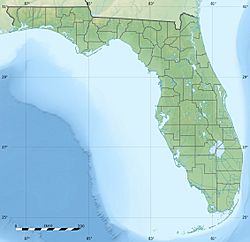Lake Wire facts for kids
Quick facts for kids Lake Wire |
|
|---|---|
| Location | south of Lakeland, Florida |
| Coordinates | 28°02′48″N 81°57′39″W / 28.0468°N 81.9608°W |
| Type | natural freshwater lake |
| Basin countries | United States |
| Max. length | 1,255 feet (383 m) |
| Max. width | 1,220 feet (370 m) |
| Surface area | 22.17 acres (9 ha) |
| Average depth | 10.8 feet (3.3 m) |
| Max. depth | 22 feet (6.7 m) |
| Water volume | 80,120,478 US gallons (303,289,000 L) |
| Surface elevation | 196 feet (60 m) |
Lake Wire is a cool, almost-round lake located right inside Lakeland, Florida. It covers an area of about 22.17 acres (89,700 m2), which is like 17 football fields! The area around the lake is very busy, with lots of buildings and roads.
This lake might have once been oval-shaped. It looks like parts of it were filled in to make space for Lake Wire Drive. This road now goes almost all the way around the lake. There's only a small gap of about 100 feet (30 m) on one side. A public sidewalk completely circles the lake, making it easy to explore.
About Lake Wire
Lake Wire is a natural freshwater lake. It's located in Polk County, Florida. The lake is not very deep, with an average depth of about 10.8 feet (3.3 m). Its deepest point is around 22 feet (6.7 m).
The lake is a popular spot for locals. It's surrounded by a public sidewalk. This means you can walk all the way around it.
Fun at Lake Wire
You can visit Lake Wire every day from sunrise to sunset. The public sidewalk lets everyone enjoy the lake's edge.
While there are no special places for swimming or boat ramps, you can definitely go fishing from the shore. Many people enjoy trying to catch fish here.
What Fish Live Here?
According to the "Take Me Fishing" website, Lake Wire is home to a couple of popular fish species. You might be able to catch largemouth bass and bluegill in its waters. These are common and fun fish to try and reel in!
Why the Name Lake Wire?
The name "Lake Wire" comes from something interesting that happened in the past. Long ago, there were poles in the lake. These poles held up telegraph wires. Telegraphs were an early way to send messages over long distances using electrical signals. So, the lake got its name because of these wires!


